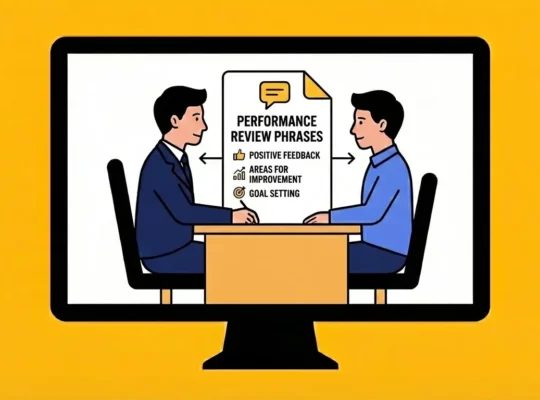Ever feel like attracting great talent is a constant battle? You’re not alone. Companies are fighting tooth and nail for the best and brightest. But what if there was a secret weapon?
It’s called your HR brand. Think of it as your company’s personality for the working world. It’s the behind-the-scenes glimpse of what your company culture is really like. It’s the way you treat your employees, the opportunities you offer for growth, and the sense of community you foster. And as much as you can advertise yourself as an employer of choice through social media and job forums, nothing tops off an authentic employee review. Review.jobs, a certified employee review platform, is your ally in building a robust HR brand. Now, let’s break down everything you need to know: what is an HR brand, why it matters, and how to craft a brand that makes people line up to work for you.
Table of Contents
I. Understanding HR Branding
II. Why HR Branding Matters
III. 4 Steps to Building a Strong HR Brand
1. Define Your Employer Value Proposition (EVP)
2. Cultivate a Positive Company Culture
3. Enhance Employee Experience
4. Craft Compelling Employer Brand Messaging
IV. Overcoming Challenges in HR Branding
I. Understanding HR Branding
Definition and Scope
HR branding refers to the process of creating and promoting an organization’s image, culture, and values to attract, engage, and retain top talent. It involves developing a unique employer value proposition (EVP) that showcases the benefits of working for your organization and crafting a compelling image of your organization as an employer.
Components of HR Branding
A strong HR brand consists of several key components:
- Employer Value Proposition (EVP): A clear and concise statement that outlines the benefits of working for your organization.
- Company Culture and Values: The core values and principles that guide your organization’s behavior and decision-making.
- Employee Experience: The sum of all interactions an employee has with your organization, from recruitment to exit.
- Employer Brand Messaging: The consistent and authentic communication of your organization’s values, culture, and EVP.
Benefits of a Strong HR Brand
By effectively leveraging the aforementioned components, HR branding allows you to:
- Attract Top Talent: When qualified candidates see a strong HR brand, they understand the unique value proposition you offer. This attracts individuals who are a good fit for your culture and contributes to a more qualified applicant pool.
- Boost Employee Engagement: A strong HR brand goes beyond attracting talent; it’s about nurturing the talent you already have. When employees feel their company genuinely cares about their well-being and professional growth, they’re more likely to be engaged and productive. Invest in the right employee engagement programs for a thriving team!
- Retain Your Best People: A positive employer image translates to a happier and more loyal workforce. When employees feel valued and appreciated, they’re less likely to seek opportunities elsewhere.
II. Why HR Branding Matters
- Attract Top Talent: A strong HR brand acts like a magnet for qualified candidates. It tells them what makes your company special, beyond just a paycheck. When potential hires see a positive employer image, they understand if your culture aligns with their values, leading to a better applicant pool and a higher chance of finding the perfect fit.
- Boost Employee Engagement: HR branding isn’t just about attracting new talent; it’s about keeping your existing employees happy and engaged. When your employees feel their company genuinely cares about their well-being and professional growth, they’re more likely to be invested in their work and become your biggest brand ambassadors. Employee engagement surveys can be highly effective in connecting with your employees and meeting their needs.
- Retain Your Best People: A strong HR brand translates to a happier and more loyal workforce. Think about it: if you feel valued and appreciated at your company, wouldn’t you be less likely to jump ship for another opportunity? HR branding helps build that sense of value and appreciation, leading to lower turnover and a more stable, experienced team.
The result? You Win the War for Talent
Competition for top talent is fierce. HR branding helps you differentiate yourself from the crowd and position yourself as an employer of choice. It’s your chance to tell the world why working at your company is truly special.
III. 4 Steps to Building a Strong HR Brand
1. Define Your Employer Value Proposition (EVP)
Think of your EVP as your company’s unique selling proposition for employees. It’s the compelling package of benefits and experiences that sets you apart from competitors and attracts the talent you seek. For that, apply the following steps:
Identify Your Unique Selling Points (USPs)
- What makes your company stand out? Do you offer a cutting-edge work environment filled with opportunities for innovation?
- Are you renowned for your commitment to work-life balance and employee well-being?
- Perhaps your company fosters a collaborative and supportive culture where everyone feels valued. Be honest and be specific.
Align Your EVP with Company Mission and Values
- Your EVP shouldn’t exist in isolation. It should be a reflection of your organization’s core mission and values.
- When there’s a clear alignment, your EVP becomes more authentic and resonates with potential hires who share your values.
Understand Your Ideal Candidate
- Who is your dream employee?
- What are their skills, experiences, and aspirations?
- What kind of work environment are they seeking?
Craft Your Compelling Message
- Once you’ve identified your USPs, aligned them with your values, and understood your ideal candidate, it’s time to craft your message.
- This message should be clear, and concise, and communicate the value proposition you offer employees.
2. Cultivate a Positive Company Culture
Value & Growth:
- Define Core Values: Establish a clear identity by identifying your core values. This guides decision-making and fosters a sense of shared purpose.
- Invest in Your People: Offer training, mentorship, and opportunities for professional development. Show your employees you care about their long-term success. Failure to do so might have dire consequences. According to a recent report, the lack of opportunities for growth and development is the number one reason people decide to leave their jobs.
Recognition & Connection:
- Celebrate Achievements: Recognize and reward individual and team wins, big or small. Public recognition boosts morale and motivation.
- Build Strong Teams: Encourage collaboration and teamwork through events and cross-departmental projects. Strong teams support each other and create a positive work environment.
Wellbeing & Openness:
- Promote Work-Life Balance: Offer flexible work arrangements and encourage employees to take their vacation time. A healthy work-life balance leads to happier and more productive employees. In fact, A survey by the Society for Human Resource Management found that nearly half (45%) of U.S. employees in small and medium-sized businesses say a wellness program offered by their employer would convince them to stay in their current job.
- Foster Open Communication: Encourage honest feedback and create channels for employees to voice their concerns. Anonymity is highly recommended for guaranteed honesty, a policy we heavily apply at Review.jobs.
3. Enhance Employee Experience
Today’s employees crave more than just a paycheck. They seek a fulfilling and engaging work experience. Here are 3 key strategies to enhance your employee experience and unlock your team’s full potential:
Focusing on Onboarding and Training Programs: Develop comprehensive onboarding and training programs to ensure a smooth transition for new employees. A Harvard Business Review discovered that a strong onboarding program could boost the productivity of new employees by 62% and increase their retention rate by 50%.
Make sure not to overlook the onboarding of remote employees!
Celebrate Achievements: Recognize and reward both individual and team wins, big or small. Public recognition and appreciation go a long way in boosting morale and motivation.
Create a Feedback Loop: Encourage open communication and two-way feedback. Actively listen to employee concerns and ideas, showing you value their input.
4. Craft Compelling Employer Brand Messaging
Crafting compelling employer brand messaging can feel overwhelming. Here’s how to break it down:
Know yourself, inside and out
- What sets you apart? Identify your unique selling points (USPs) – is it your innovative work environment, commitment to work-life balance, or collaborative culture? Understanding what makes you special is the foundation of your message.
- What are your values? Your core values are the guiding principles of your organization. Align your messaging with these values to create an authenticity that resonates with potential hires who share your beliefs.
Speak to your ideal candidate
- Who is your dream employee? Understand their skills, experiences, and aspirations. What kind of work environment are they looking for?
- Tailor your message to their needs and desires. Highlight specific aspects of your company culture and benefits that would appeal to them. This ensures you attract the perfect fit.
Focus on benefits, not features
- Don’t just list features like “competitive salary” or “health insurance.”
- Translate features into benefits. For example, instead of simply saying “health insurance,” emphasize how it provides peace of mind and contributes to employee wellbeing.
- Use strong verbs and action-oriented language to create a message that excites and motivates potential hires.
Keep it authentic
- Authenticity is key. Don’t create a picture-perfect image that doesn’t reflect reality.
- Showcase your company culture through employee testimonials with Review.jobs and let your employees be your brand ambassadors!
- Share candid behind-the-scenes glimpses, and stories that highlight your unique character.
IV. Overcoming Challenges in HR Branding
Lack of Internal Alignment
This can be overcome by ensuring that all departments are aligned with the organization’s values, culture, and EVP.
Limited Resources and Budget Constraints
Prioritize initiatives and leverage cost-effective strategies, such as employee advocacy and social media.
Adapting to Changing Market Trends and Employee Expectations
This involves staying up-to-date with the latest trends and employee expectations, such as personalized employee experiences and employee-centric content marketing.
So, there you have it! Building a strong HR brand isn’t rocket science, but it is a game-changer. It’s about attracting the kind of people who make your company buzz with creativity and energy. It’s about keeping your existing crew happy, fulfilled, and ready to tackle any challenge. Here at Review.jobs, we get it. We’re passionate about helping companies build rock-solid HR brands. Because when you get it right, it’s a win-win for everyone. You attract amazing talent, your employees love coming to work, and your company thrives. Now, are you ready to build your employer brand and start attracting your dream team? We’re here to help!





